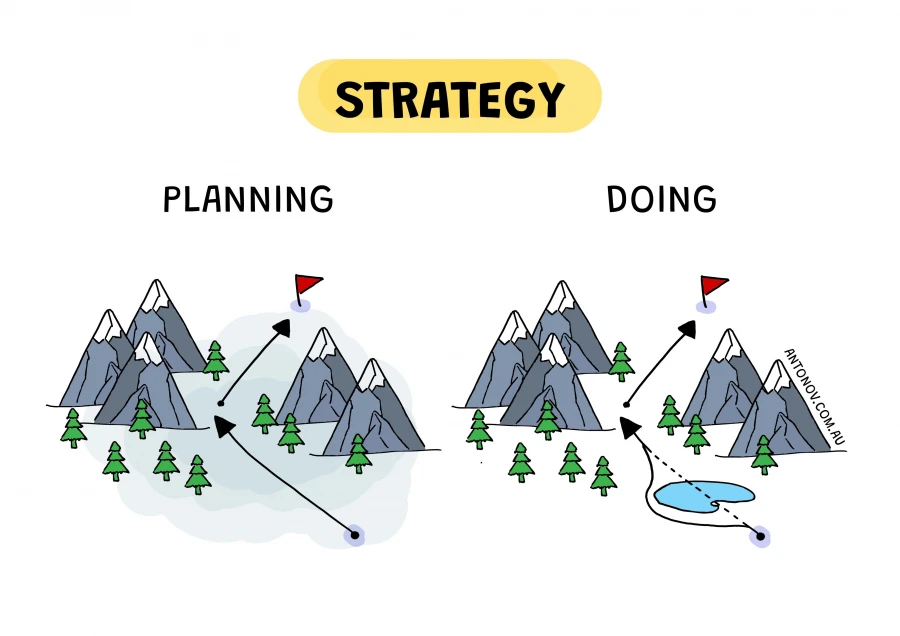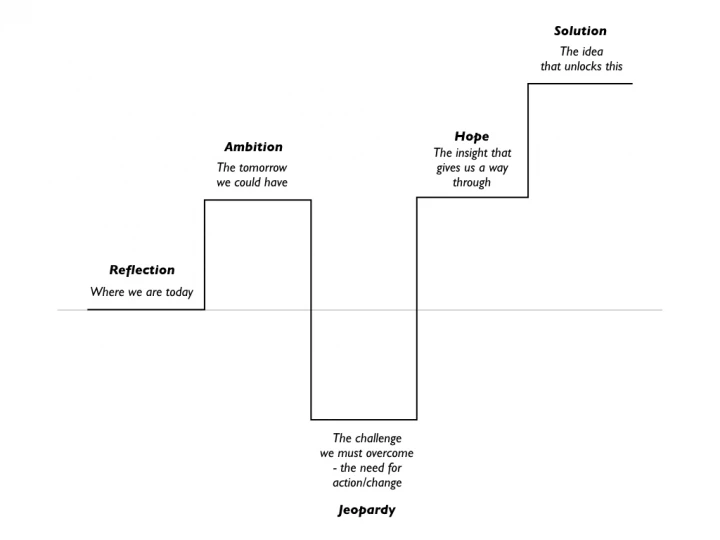-
Simple Strategy
An exciting strategy is something that people look forward to. The all-hands meetings, the inspiring slogans, the promise that this next big bet will change everything.
But real strategy doesn't spar... Read more -
Not sure your strategy is clear?
Ask 3 people to explain it back.
If the answers don't match, your strategy isn't working - it's just words on a page. Rewrite until their answers sound like a chorus. Strategy isn't just about direction. It's about shared language. -
The best leaders simplify trade-offs.
They don't avoid the tough calls. They make the path feel obvious - even when it isn't.
Don't just ask: “Why now?”
Ask: “What gets dropped if we do this?”
Passionate founders can find a hundred reasons why everything matters. Revenue. Growth. Strategy. Buzzwords galore. But trade-offs force clarity. If nothing gets cut, it's not a real decision. -
Strategy. Practical tips.
Most teams quietly tiptoe around a simple truth...many leaders don't actually know what a good strategy looks like, let alone how to create one.
They've never read Good Strategy Bad Strategy or Blue ... Read more -
A great product strategy doesn't just come from what you might build. It comes from being just as clear on what you won't.
There are two lists every product team needs. One is obvious: the wishlist. Features you'd love to build one day. The shiny ones. The creative experiments. The nice-to-haves that make you dream.
The other list? The never list. Just as powerful, even more clarifying. Features you'll never build. Because they break your strategy. Dilute your brand. Creep into someone else's territory. Or solve problems you deliberately chose not to solve.
This list sets your guardrails. It keeps sales from selling ghosts. And it makes every yes sharper - because every no is clear.
Focus doesn't come from chasing every idea. It comes from knowing which ones to kill. -
Bad strategy documents aren't your fault.
You join a new team. You're handed a 30-pager full of buzzwords, abstract goals and empty phrases. You read it. You reread it. Still lost.
It feels like you're the problem. You're not. The document is.
Most strategy docs aren't written to be understood. They're written to impress. Or to tick a box. They sprawl with vague visions and empty frameworks, then expect alignment to magically follow.
But the job of a strategy isn't to sound smart.
📘 The job of a strategy is to create clarity. Direction. Focus. And what to ignore.
A good strategy is short and sharp. Like a pitch. You should be able to explain it in 30 seconds. Use SCQA if you need help: Situation, Complication, Question, Answer.
If you're a Product Manager, that's your job. Not just writing the doc. Shaping the strategy. Testing it. Pressure-proofing it with your team and execs.
So if you're staring at a bloated, broken strategy, don't wait for permission.
Tear it apart. Make it clearer. Make it tighter. Make it usable.
Alignment doesn't come from reading. It comes from understanding. -
No one starts with a perfect strategy. That's just not how it works.
You set a few goals, spot the obvious roadblocks and take your first steps. How about the rest you might ask? You figure it out along the way. Just keep an eye on the market and overall trends and adjust your strategy as needed. And yeah, unexpected problems will pop up. That's normal though. They aren't failures - just part of the process. Every setback teaches you something.
A plan points you in the right direction, but real clarity comes from doing the work. The teams that adapt, adjust, and keep moving - especially when things feel uncertain - are the ones that make real progress.
So don't wait for the “perfect” plan. Just start. You'll get there.

-
A strategy isn't about looking smart. It's about making sure everyone understands it.
Clarity beats complexity in any organisation. A strategy packed with jargon or overblown ideas creates confusion, not action. The goal is alignment - getting everyone moving in the same direction with confidence.
Simple, clear strategies win because they get executed. -
The word "agility" has lost its meaning.
The word itself went on a journey from being cool to becoming a buzzword. Teams seem to avoid using the word "agile" because it's no longer considered cool.
The reason for this is that quite often, agility is used as a way to mimic strategy.
It becomes a way to justify changes in direction - simply because you're agile.
The underlying problem, however, is the lack of strategy driving that movement.
Strategy is like a map. With broad strokes, you can outline your obstacles - the mountains, so to speak - that you need to navigate to reach your destination, your vision.
Interestingly, anything close by might appear foggy. You can't see it clearly but you can see the destination.
Sometimes, as you move forward, you encounter obstacles you didn't foresee, things that were hidden. It could be something small, like a lake. So you pause, check out the lake and consider the best way to handle it.
That's your agility - helping you navigate these small obstacles and unforeseen challenges without losing sight of the destination.
Is Agile dead?
The word might be dead but businesses that succeed combine an explicit strategy with a willingness to adapt. These businesses will move much faster than those relying solely on strategy or agility. You need both to succeed. -
A strategy document should guide, not confuse.
The purpose of strategy is to align and direct an organisation toward shared goals. When it's overly complicated, it fails its primary mission. Strategy should be simple, clear and actionable.
As a product manager, your role is to create alignment. Work with your team and stakeholders to ensure clarity. If the strategy you're handed is unclear, don't sit with confusion. Simplify it. -
A successful product balances execution and vision. As Melissa Perri highlights, it's not just about delivering but steering in the right direction. Markets shift. Challenges arise. Opportunities emerge. Pivoting with purpose defines lasting success.
A good company strategy should be made up of two parts: the operational framework, or how to keep the day-to-day activities of a company moving; and the strategic framework, or how the company realizes the vision through product and service development in the market.
-
A powerful strategic narrative creates clarity, not complexity.
If you're a business leader, team lead or strategist looking to align and motivate people around a clear direction, the posts you've shared offer a goldmine of principles that support and extend the Strategic Narrative Tool (from Strategy Needs Good Words). That framework asks teams to define who they are, where they're going and why it matters - then communicate it in a way that inspires action. Here's how your writing already lives that out:
Start with decisions, not slogans. Your offsite advice is sharper than most strategy decks:
“What will we say no to? What will we fund? What changes Monday morning?”
That's not theory. That's a story people can follow. Strategic narrative works when it starts with choices.
Make clarity the culture. Culture isn't vibes - it's behaviours.
“What's praised. What's punished. Used in hiring. Reinforced in feedback. Lived under pressure.”
Strategic narratives lose power when values sound good but mean nothing. You show how to anchor them in action.
Keep repeating the vision. You call out a mistake many founders make:
“They think one deck, one all-hands, one strategy doc is enough.”
But repetition builds rhythm. A good narrative becomes the background music of the company.
Direction beats alignment. When teams stall, it's not due to lack of planning. It's lack of clarity.
“Don't confuse a plan with a strategy. Don't confuse activity with progress.”
Strategic narratives should simplify the noise, not add to it. You deliver that.
If someone asked how to put a strategic narrative into action, this writing is the how.
No fluff. Just sharp words, used well, to drive clarity and action.
That's what moves teams. That's what builds belief.

-
Agility is misunderstood. True agility adapts to change without succumbing to chaos. It's never about rushing decisions.
The best teams balance flexibility and structure. Agility thrives on collaboration, iterative progress and responsiveness - anchored by clear direction. Without this balance, chaos replaces speed and quality falls victim to a mirage of progress.
Agile isn't a strategy. It's how strategies breathe.
Agile vs Strategy
